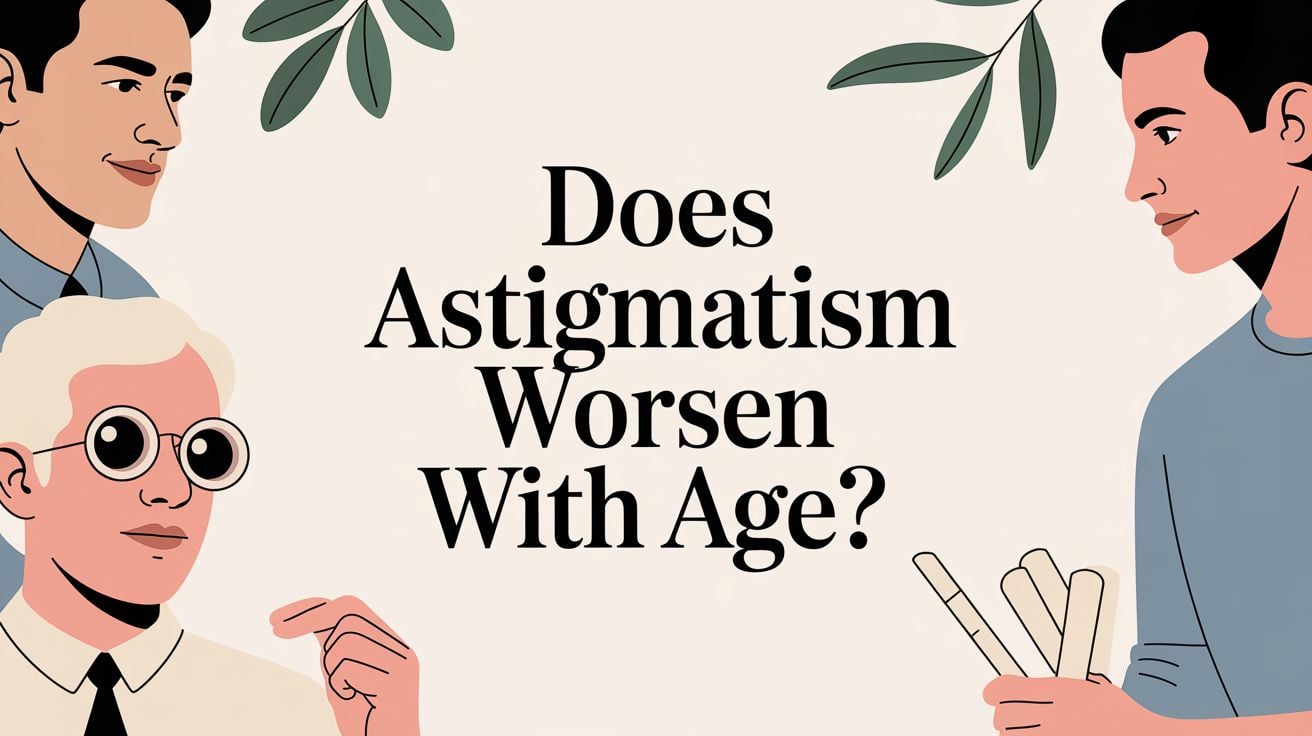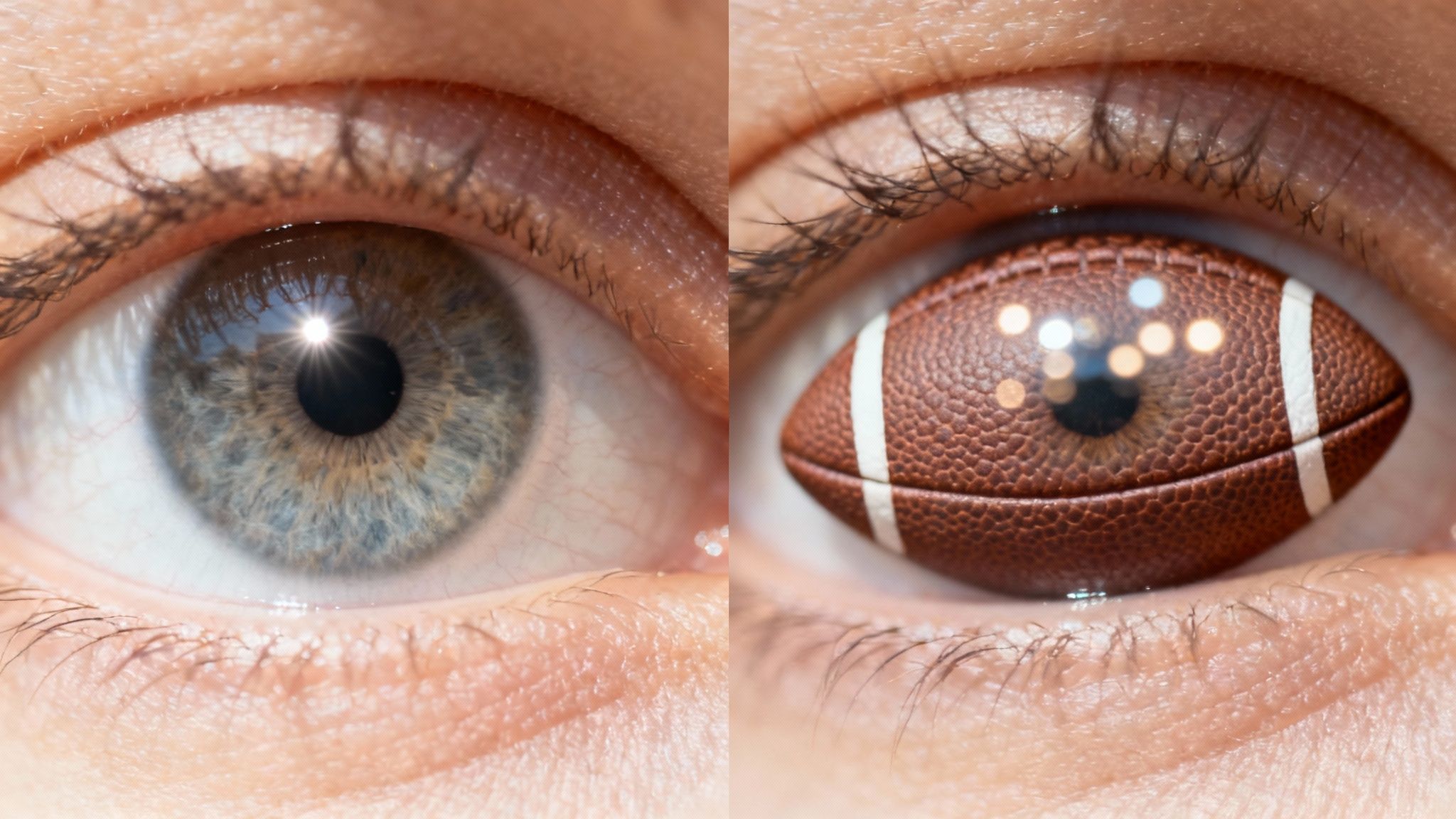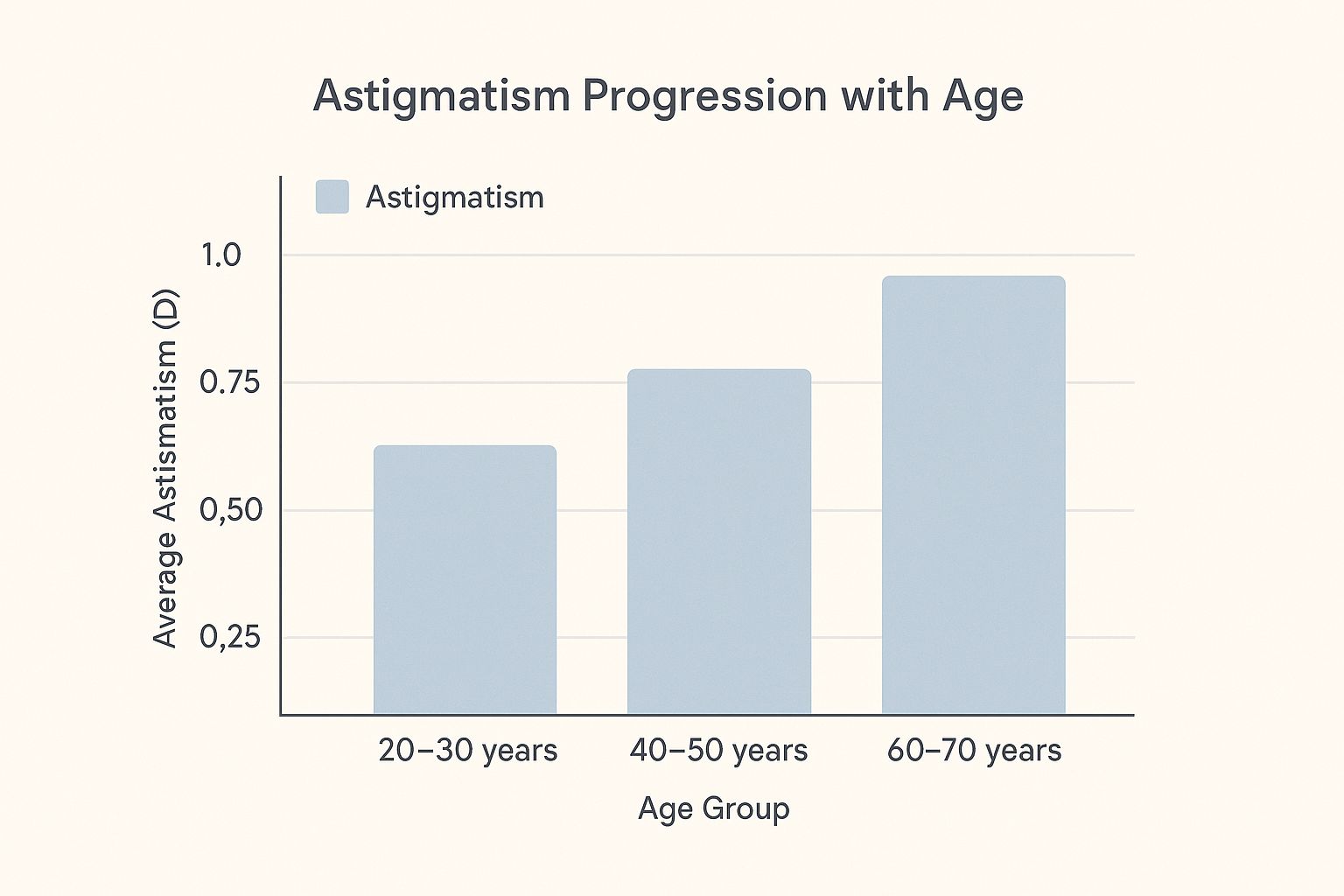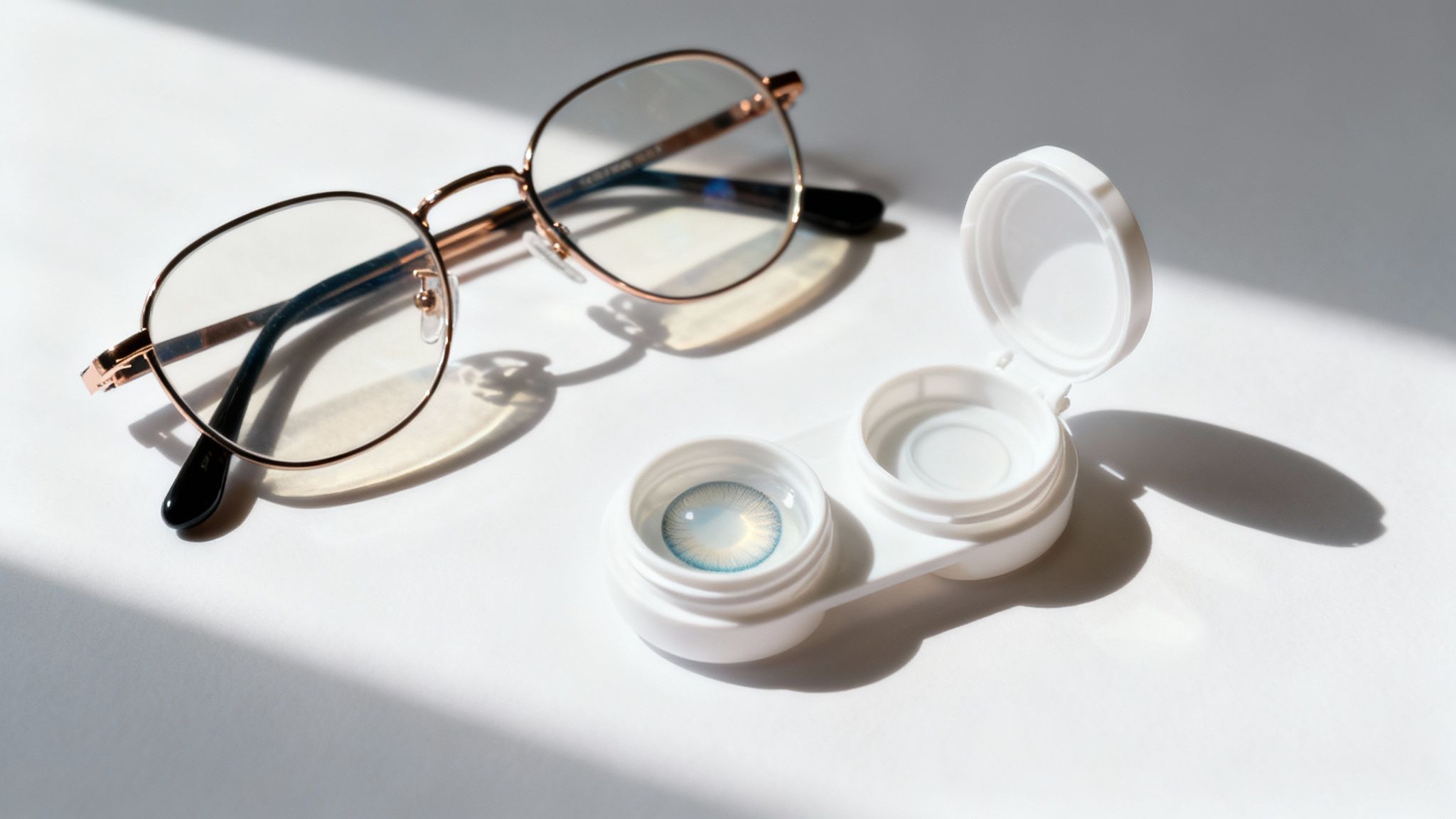It's a common question we hear from patients at our Glendale Heights boutique: does astigmatism get worse over time? The short answer is yes, it can, but it’s usually a very slow and manageable process. If you live here in Glendale Heights or the surrounding suburbs, understanding how your eyes change is the first step toward maintaining clear, comfortable vision for life.
For most people, especially between the ages of 20 and 40, their prescription stays remarkably stable. But as we get older, our eyes naturally change—the lens inside the eye loses flexibility and the cornea can shift slightly. These small changes can cause a gradual shift in your astigmatism, particularly after you hit 40.
What Is Astigmatism and How Does It Affect Vision?
Before we get into how astigmatism changes with age, let's break down what it actually is in simple terms. Think of a perfectly healthy eye as being shaped like a basketball—nice and round. When light enters, it bends evenly and focuses on a single, sharp point on the retina at the back of your eye. The result? Crisp, clear vision.
Now, imagine an eye with astigmatism. It’s shaped less like a basketball and more like a football. This irregular curve means that when light enters, it scatters and focuses on multiple points instead of just one. This focusing issue creates blurry or distorted vision at all distances, whether you're reading a book up close or looking at a sign down the road. It’s an incredibly common condition that affects millions of people.
Common Symptoms and Types
This simple mismatch in how your eye focuses light can lead to some really frustrating daily symptoms. If any of these sound familiar, astigmatism might be the culprit:
- Vision that’s consistently blurry or distorted
- Finding yourself squinting to try and see clearly
- Tired, strained eyes, especially after reading or screen time
- Headaches that seem to kick in after you’ve been focusing for a while
- Trouble with night vision, like seeing halos or starbursts around lights
Astigmatism generally comes in two main flavors. Corneal astigmatism is the most common, caused by an irregularly shaped cornea (the clear front surface of your eye). The other is lenticular astigmatism, which comes from a misshapen lens inside your eye. Both types do the same thing—prevent light from focusing correctly—but the good news is that they are both easily correctable.
You can learn more in our detailed guide on what astigmatism is.
Astigmatism is not only widespread but also varies quite a bit depending on age and where you live. Globally, studies show it affects approximately 40.4% of adults and 14.9% of children. This makes it one of the most common refractive errors on the planet.
For our neighbors here in Glendale Heights, understanding these fundamentals is the first step toward getting back to sharp, comfortable vision.
How Your Eyes Change As You Get Older
Just like every other part of your body, your eyes evolve throughout your life. So, when people ask, "Does astigmatism get worse with age?" the short answer is yes, it often does. But it's not usually something that happens overnight—it’s a slow, natural progression tied directly to how our eyes mature.
What Happens Inside Your Eye?
Two key things are happening as the years go by.
First, the lens inside your eye starts to lose its flexibility. Think of it like a brand-new rubber band versus one that's been sitting in a drawer for a decade. This stiffening process is called presbyopia, and it’s the reason so many of us find ourselves reaching for reading glasses in our 40s. While presbyopia is a separate condition, it can make the blurriness from your existing astigmatism feel much more pronounced.
At the same time, the cornea itself can subtly change shape. It might sound strange, but the gentle, constant pressure from your eyelids blinking over decades can gradually alter its curvature. These tiny structural shifts are a major reason why an astigmatism prescription that has been stable for years might start to creep up.
Astigmatism's Progression Through Life
Studies back this up, showing that astigmatism is more common and often more significant in older adults. For example, people aged 70 and above typically have a higher degree of astigmatism than younger folks, all thanks to those long-term changes in the eye's structure.
The chart below gives you a clear visual of how astigmatism tends to increase, measured in diopters, as we get older.
As you can see, there's a definite upward trend. This progression is a perfect example of why your vision needs aren't set in stone.
To help you understand this timeline a bit better, here's a breakdown of how astigmatism typically progresses through different stages of life.
How Astigmatism Progresses Through Life Stages
| Age Group | Typical Astigmatism Change | Primary Cause |
|---|---|---|
| Childhood (0-18) | Often present from birth; can decrease or stabilize. | Natural eye growth and development. |
| Young Adulthood (19-40) | Generally stable for most people. | The eye has typically finished its primary growth phase. |
| Middle Age (41-60) | May begin to slowly increase. | The lens starts losing flexibility (presbyopia); eyelid pressure begins to have a cumulative effect on the cornea. |
| Seniors (61+) | More likely to see a noticeable increase in prescription. | Continued stiffening of the lens and long-term changes to the cornea's curvature. |
These patterns highlight why regular eye exams are so important, especially as you enter your 40s and beyond.
For many, these changes aren't just about astigmatism. That same stiffening of the lens can create a whole new set of focusing challenges.
If you're suddenly struggling to read a menu and see a street sign clearly, you might be dealing with more than just astigmatism. It's a classic sign that it might be time for bifocals. Check out our guide to learn how to tell if you need bifocals.
This can make everyday tasks, like that drive home along North Avenue after work, feel a lot more difficult. The good news is that these age-related vision changes are very common and easily managed with the right corrective lenses and professional care.
Key Signs Your Astigmatism Is Changing
So, how can you actually tell if your astigmatism is changing? It's not always a dramatic shift. The changes are often subtle, creeping in so slowly that you might just write them off as being tired or stressed.
But paying attention to these small clues is the key to keeping your vision as sharp and comfortable as possible.
You might notice that certain tasks have become trickier. Driving at night is a big one. Do headlights and streetlights seem to have more pronounced halos or starbursts around them? That classic glare is a tell-tale sign that the way your eye is bending light has altered.
From Small Nuisances to Clear Warnings
Other signs can pop up during your everyday activities. Think about your day-to-day life and see if any of these sound familiar:
- More frequent squinting: Do you find yourself constantly narrowing your eyes to read a street sign or see your computer monitor clearly?
- Persistent headaches: Are you getting more headaches that feel like they're centered behind your eyes, especially after reading or screen time?
- Noticeable eye strain: Do your eyes just feel worn out and fatigued by the end of the day?
These aren't just minor inconveniences; they are your eyes sending you a direct message. They're telling you that your current glasses or contacts aren't doing their job correctly anymore. Sometimes, you might even notice that the blurriness is more pronounced in one eye than the other, which can happen when astigmatism changes unevenly. If you've ever asked yourself why just one eye seems blurry, this could be the culprit.
Key Takeaway: If you're experiencing more trouble with night driving, find yourself squinting constantly, or are dealing with regular eye-strain headaches, your astigmatism has likely changed. These symptoms are a clear signal that it's time for an eye exam.
Recognizing these signs gives you the power to do something about it. Instead of just putting up with worsening vision, you can see these changes for what they are: a prompt to schedule an appointment and get your eyes checked.
Modern Ways to Manage Astigmatism
The great thing about modern eye care is that even if your astigmatism shifts over time, you don't have to settle for blurry vision. Clear, comfortable sight is always within reach, and today’s solutions are more personalized and effective than ever before.
Let’s look at the most common and effective ways we can correct for those changes.
Prescription Eyeglasses and Advanced Lenses
For most people, a pair of well-made eyeglasses is still the most straightforward and reliable way to manage astigmatism. We’ve come a long way from old-school lenses.
Modern digital lens technology allows us to create glasses that perfectly counteract the unique curvature of your eye. This means you get crisp, clear vision from edge to edge, finally getting rid of that frustrating distortion and blur.
Of course, getting an updated prescription doesn't mean you have to sacrifice style. We're a leading provider of designer eyeglasses in Glendale Heights, so you can pair that perfect vision with frames from iconic brands, including:
- Cartier
- Tom Ford
- Gucci
- Oliver Peoples
Our job is to help you find that perfect match—the right lenses for your vision and the right frames for your look.
Specialized Contact Lenses
If you're more of a contact lens person, you’re in luck. Toric contact lenses are designed specifically for the challenge of astigmatism.
Think of it this way: a standard contact lens can spin freely on your eye, which is a big problem when you need a specific orientation to correct the blur. Toric lenses, on the other hand, are engineered with a unique weighting or shape that keeps them stable and locked into the right position. The result is consistently clear vision all day long.
A professional fitting is absolutely critical for toric lenses. Our team ensures your contact lenses in Glendale Heights provide the perfect blend of sharp sight and comfortable wear. For a deeper dive, check out our guide on the 5 best toric contact lenses for astigmatism correction.
For those looking for a more permanent fix, refractive surgery like LASIK is another popular path. By reshaping the cornea itself, these procedures can correct astigmatism at its source. While it's an excellent option for many, it’s not for everyone, so a thorough consultation is the first step to see if you're a good candidate.
Why Regular Eye Exams Are Your Best Defense
When it comes to your eyes, being proactive is the secret to maintaining healthy vision for life, especially as you get older. That’s why we see routine check-ups as so much more than a quick stop for a new prescription.
Think of it this way: since astigmatism can subtly worsen over time, an annual exam is the best way to catch those small shifts before they become big problems. Without that regular check-in, you might find yourself putting up with avoidable eye strain, headaches, or frustratingly blurry vision, not knowing that a simple prescription tweak is all you need.
More Than Just a Prescription
We’ve built our exam process to be incredibly thorough. During one of our 30-minute detailed eye exams in Glendale Heights, we use high-resolution imaging to map out the exact shape of your cornea and track even the tiniest changes in your astigmatism.
This technology does more than just refine your prescription. It’s also our first line of defense for spotting other serious, age-related conditions that often sneak up without any warning signs, including:
- Glaucoma
- Cataracts
- Macular Degeneration
This is how we protect your vision from every angle. Regular exams are the key, and the diagnostic tools we use are always getting better. Keeping up with innovations like the future of medical imaging shows just how much these technologies help us guard your long-term eye health.
An annual eye exam is like preventative maintenance for your most important sense. It’s the single best thing you can do to protect your sight from the changes that come with age.
For our neighbors in nearby Carol Stream and Bloomingdale, putting your eye health first has never been easier. Our approach is all about giving you peace of mind and keeping your vision sharp for the long haul. Don’t wait for your vision to get worse—take the first step by booking one of our detailed eye exams in Glendale Heights today.
Your Partner for a Lifetime of Clear Sight
Knowing that astigmatism can shift as we get older is the first step, but it's what you do with that knowledge that truly matters. Yes, our eyes change over time—that's a completely normal part of life. But it should never mean giving up the crisp, comfortable vision you deserve.
That's where we come in. At iDoctor, we see ourselves as more than just an eye doctor in Glendale Heights; we're your dedicated partners in lifelong vision health. Whether the solution is an updated pair of luxury Tom Ford glasses or advanced toric contact lenses, our job is to ensure you see your world with stunning clarity.
Your journey to lasting clear vision starts with a simple conversation. After enjoying a beautiful day at East Branch Forest Preserve, stop by our boutique on your way home. We're here to help you navigate every change with confidence and style.
FAQs About Astigmatism in Glendale Heights
At what age does astigmatism usually start to change?
While your prescription is often stable in your 20s and 30s, it’s common to see gradual changes begin after age 40. This is due to natural stiffening of the eye's lens and subtle shifts in the cornea's shape over time. That's why an annual check-up with the best optometrist in Glendale Heights is so important as you get older.
Can I get designer frames like Gucci or Cartier with a strong astigmatism prescription?
Absolutely! At iDoctor, we specialize in fitting high-prescription lenses, including those for significant astigmatism, into luxury frames. Whether you're looking for Cartier glasses near me or the latest from Prada, our team ensures your designer eyeglasses in Glendale Heights provide both flawless vision and a perfect fit.
Does my vision insurance cover exams and glasses for astigmatism?
Yes, in most cases it does. iDoctor accepts all major vision insurance plans, which typically cover comprehensive eye exams needed to diagnose and manage astigmatism. Many plans also provide an allowance for prescription eyeglasses or contact lenses. Our friendly staff can help you understand and maximize your benefits.
Ready to see the difference that expert care and exceptional eyewear can make? Schedule your appointment with iDoctor today and let us help you achieve a lifetime of clear, comfortable vision.








